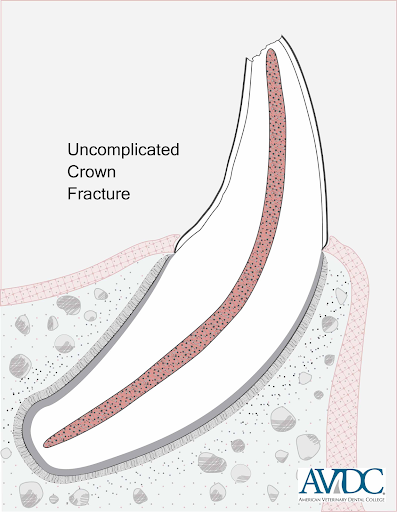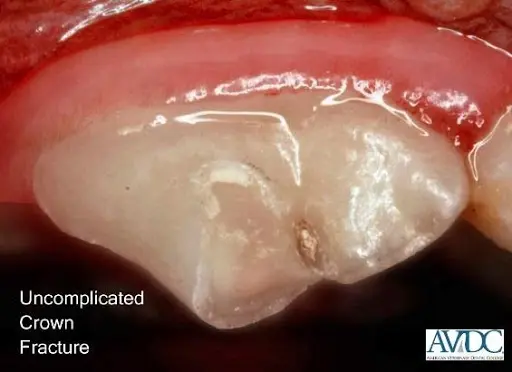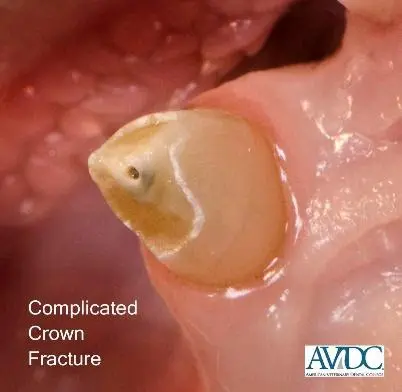
10 Sep What Should You Do If Your Dog Chips a Tooth?
A “chipped” tooth is a term used to describe a crown fracture in which the outer layer (enamel) of your dog’s tooth has been fractured, exposing the underlying dentin. To some, these “chipped” dog teeth may seem insignificant, however, this is often not the case. Fractures of this nature are painful and, if left untreated, can lead to infection and death of the tooth.
Even though a “chipped” tooth often refers to a tooth with an uncomplicated crown fracture (no pulp exposure), it can be difficult to discern between uncomplicated and complicated crown fractures (pulp exposure) during an awake oral exam. I will discuss both types of fractures, but will focus mostly on uncomplicated crown fractures.
Anatomy of the Tooth
The tooth is made up of these 4 distinct tissues: pulp, enamel, dentin, and cementum.
- The pulp is the innermost layer of the tooth, located in the pulp chamber and root canal. The pulp contains blood vessels, nerves, and connective tissue. The blood supply and nerves enter and exit through the apical delta, which is located at the root apices (tip).
- Enamel is the impermeable, outer layer of the crown of the tooth. It is mostly mineral (97%) and is the hardest tissue in the body. The enamel of dogs and cats is approximately 1mm thick which is much thinner than the enamel of human teeth. Enamel is produced during the development of the tooth. Once the tooth erupts, enamel is no longer produced. Therefore, any enamel damaged or chipped cannot be replaced.
- Cementum is a mineralized substance that covers the root of the tooth. Cementum seals the root from the surrounding tissue. It also serves as the anchor point for the periodontal ligament to the tooth and holds it in the socket.
- Dentin is produced throughout the life of the tooth. It is the second hardest substance in the body and makes up the bulk of the structure of the tooth. Dentin has tubules that run from the inner pulp chamber/root canal to the outer surface of the dentin. These tubules contain processes of odontoblasts and fluid, all of which function in a sensory capacity. Exposure of the surface of dentin results in a pain sensation. The dentin is covered by enamel on the crown or cementum on the root.
Crown Fractures
Trauma to the tooth can result in a tooth fracture. Commonly, tooth fractures are a result of inappropriate chew toys (rocks, antlers, bones, etc) or other trauma. Tooth fractures are painful, but dogs rarely show symptoms of pain, and so these fractures may go unnoticed. Crown fractures are divided into uncomplicated or complicated crown fractures.
Uncomplicated crown fractures are fractures of the enamel, exposing the dentin. These fractures do not expose the pulp. Complicated crown fractures are fractures of the enamel and dentin and extend into the pulp chamber, exposing the pulp. It is important to be able to identify whether the fracture is complicated or uncomplicated because the treatment for each is different.




Complete diagnosis of a crown fracture includes a visual exam with probing of the fracture site under anesthesia and diagnostic imaging, either dental radiographs or cone beam CT scan. Diagnostic imaging is a critical part of the evaluation of the fractured tooth and is necessary for making treatment decisions.
Treatment of “Chipped” Fractured Dog Teeth
Teeth with uncomplicated crown fractures are commonly treated in veterinary dentistry. It is important to identify these teeth as early as possible after the fracture. In the case of an uncomplicated crown fracture, if the tooth is periodontally sound and has no evidence of infection of the pulp these “chips” may be treated with bonded sealant therapy. This treatment includes smoothing the fracture site, making it less plaque retentive and sealing the tooth with a bonding agent to prevent the invasion of bacteria.
If left untreated, the concern is that bacteria can travel through tubules of the exposed dentin to the pulp and infect the tooth. Any tooth with an uncomplicated crown fracture that shows evidence of infection must not be treated through bonded sealant therapy. These teeth must be treated by either root canal therapy, which saves the tooth, or extraction. Similarly, teeth with complicated crown fractures are always treated by either extraction or root canal therapy.
Followup Exam
Any treated, fractured tooth should be evaluated between 6-12 months following treatment. This followup is to ensure the vitality of any teeth treated with bonded sealant therapy and to evaluate treatment success of any tooth treated with root canal therapy. Follow up exams should be performed under anesthesia and should include diagnostic imaging.
READ More about Caring For Your Pet After Dental Surgery
Treating Chipped Dog Teeth in Colorado Springs
Crown fractures are painful and can affect the quality of life of our pets. It is important to identify tooth fractures, both uncomplicated “chips” and complicated fractures, as soon as possible so a treatment plan may be set.
Catching a chip fracture early and treating the tooth with bonded sealant therapy can save the tooth. Here at Animal Dental Care and Oral Surgery, we pride ourselves on the level of detail we pay to our patients. Through the identification and treatment of dental diseases affecting our patients, our goal is to maximize their quality of life so we can enjoy our time with them in beautiful Colorado Springs.


